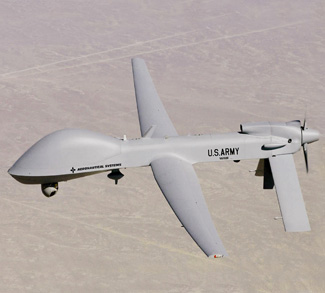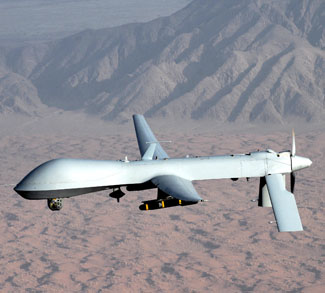Over the past decade, the United States (US) and its Central Intelligence Agency (CIA) have waged a violent drone campaign in Pakistan, years of what many detractors of America’s drone policy have lumped into the US’ much larger and felonious “dirty wars.” The death toll, as a result of US drones, reached its highpoint in 2010 with approximately 122 strikes made against a long list of militants, operatives, leaders, and suspected terrorist from a wide spectrum of jihadi militant organizations.
Casualty estimates, as noted by the Bureau of Investigative Journalism, at the beginning of 2014 put the total number of strikes by the US government via its militarized machines at 383 (332 of which are labeled Obama strikes), with the highest estimate of total killed reaching just over 3,700 and nearly 1,700 injured. Over the past two years, those numbers have decreased – merely 11 strikes in 2015 and three in 2016 according to the Center for Pakistan and Gulf Studies (CPGS). During the most recent round of strikes, the US claimed the death of Hakeem Ullah Mehsood – the former Chief of Tehrek-i-Taliban Pakistan (TTP) and Ameer Mullah Akhtar Mansoor of the Afghan Taliban.
By the end of 2013, an interesting lull in drone strikes was observed, leaving some to wonder what the US had ended its drone campaign in Pakistan, including the Federally Administered Tribal Areas (FATA). In early 2014, The New America Foundation reported the latest drone strike took place in Pakistan on Wednesday, December 25, 2013 in the Qutab Khel village of Miran Shah in the North Waziristan tribal area. The attack, which resulted in the death of several militants, was orchestrated 130 days since their reporting, serving to demarcate a period in which the longest restraint in the US drone war in Pakistan since it began in 2004 can be observed. So, where have all the drones gone? Did Pakistan’s extensive military ground operations drive militants out of FATA and into neighboring areas?
Extremist relocation is one reasonable explanation why target location may have proven difficult lately, particularly with the allure of the Islamic State (ISIS/Daesh) and the opportunity to show loyalty to the Jihadist group that stunned even the most powerful states during it emphatic 2014 land-grab in Syria and Iraq.
A number of sources suggest that the US has brought an end to its campaign of so-called “targeted killings” at the request of the Pakistani government (following the accidental killing of 24 Pakistani soldiers by a US drone at a border crossing) in order to pursue potential peace talks with the Pakistan Taliban (TTP). Others claim that the sudden change in state-sanctioned violence represented an unequivocal change in US policy. “[W]e still don’t know,” states Naureen Shah, advocacy advisor to Amnesty USA, “if the reason why there haven’t been strikes is because there is a more stringent standard of who is an imminent threat… or is the reason there is no strikes just purely because of diplomatic reasons?”
Both the CIA and the Joint Special Operations Command (JSOC) have enjoyed the use of US military bases and special facilities in Afghanistan from which to launch strikes against targets in Pakistan and adjacent areas.
America’s “ultimate voyeurs” (a term applied to those who pilot America’s Unmanned Aerial Vehicles [UAVs] in Tonje Hessen Schei’s documentary about drones) have continued with their work elsewhere (i.e., Somalia and Yemen), however, speculation is rising that the US could be depending less on the use of drones in the foreseeable future. This is highly unlikely with the US having ended its ban on the export of drones, and the proliferation of drone arsenal and trade throughout Central Asia and East Asia.
What is the likelihood that the US has actually hit the “stop” button on the drone war in Pakistan? Despite the ebb in Pakistan strikes, a significant rise in US drones strikes has been observed in Somalia during 2015. US strikes against al-Shabaab nearly quadrupled from 2014 to 2015. Drone strikes did not figure so prominently in Somalia since the drone war in that country began.
Since 2014, Boko Haram pledged allegiance to ISIS, and al-Shabaab militants massacred 150 university students in Kenya. The attacks left the African Union buzzing the US has been increasing its numbers in the region thought to have been secure. Whether the US presence in Somalia is based on training, and the US military is there to take a more active role in suppressing the return of terrorist and insurgent threats, is speculative.
President Barack Obama has authorized seven times more drone strike than his predecessor George W. Bush. It is probably impossible to hit the stop button on the lethal drone strike campaign. The trend pervades both the major political parties of the US and Washington has made its drone strike the overarching counterterrorism policy of the US. Under a President Bernie Sanders, Donald Trump, or Hillary Clinton should be expected to continue at the same pace and on the same scale as seen during the previous eight years.
Chris Cole, of Global Research, has argued that the longer the US suspends its killing program in Pakistan, “the harder it will perhaps be to justify re-starting them.” “Over the next few months,” he asserted, “drone operations will continue in Afghanistan and may even increase as the deadline to withdrawal approaches.” No shortage of US military bases or personnel exists to carry out further attacks in Pakistan or the surrounding region.
Both the CIA and the Joint Special Operations Command (JSOC) have enjoyed the use of US military bases and special facilities in Afghanistan from which to launch strikes against targets in Pakistan and adjacent areas. However, despite a statement released by the New York Times that with the complete withdrawal of US forces from Afghanistan was likely going to “imperil drone operations in Pakistan,” other options to facilitate renewed attacks by America’s predators were well within reach of Washington and remain so today.
The future of US drones in Pakistan is predicated on the use of new bases in Central Asia. Russia Today (RT) noted that, “[t]o continue counterterrorism operations abroad after the imminent exit of American troops from Afghanistan, the United States is reportedly pursuing plans to put US drones inside air bases in Central Asia.” Joshua Kucera, who writes for The Bug Pit website, resists the idea that the US will be able to look to other places in Central Asia as a means serving its covert military operations in the region for a number of reasons. “Tajikistan is highly susceptible to Russian pressure, and the Kremlin is surely not inclined to let the US reestablish its military presence in Central Asia,” writes Kucera, who added:
Uzbekistan might be willing to host a base and is relatively immune to Russian pressure, but is a bit of a bête noire in Washington and setting up a drone base there would surely face resistance from human rights-inclined members of Congress. And Turkmenistan would have some of the same problems as Uzbekistan, but also has a proudly held neutrality that would seem to preclude hosting US drones.
Technology, on the other hand, can easily mitigate the problematique posed by sheer distance in the US drone war in Pakistan. Longer flight times are said to be a remarkable hindrance to drone operators’ luxury of leisurely navigating extensive territory in search of targets. More advanced versions of the Predator and Reaper, as well as the Avenger and X-47B (with an non-refuel range of six hours or 3,900 km) drones would have no trouble reaching targets at great distances. Even the Iranian military possesses a militarized drone that can reach much of the Middle East (including Israel). More advanced US drones were developed several years ago and have already been produced and deployed (even if in relatively small numbers).
As drone operations continue to take place in Afghanistan and elsewhere in Central Asia, the Middle East, and Africa (where they appear to be increasing), the US remains ideally poised to resume its war in Pakistan in the near future. Failed talks with the TTP and turbulent outcomes of the general elections held in 2013 provided valuable pretexts for US drones to take to the skies over Pakistan for the remainder of 2014 and beyond. They did just that but in relatively fewer numbers.
What some have termed the “drone strike pause” is akin to the lull in lethal activity witnessed in drone operations in Pakistan during 2007. In 2015, Islamabad developed its own armed drone, representing a big step forward in the proliferation of weaponized drone usage and signaled that Pakistan was eager to act as a champion of the US’ targeted killing norm that it has been slowly but steadily establishing over an extended period of time, and not necessarily since 9/11.
When Islamabad stated openly that it would be employing its own weaponized drones against terrorists in the country the declaration might be interpreted as an ambiguous invite to what the US has already been engaged in for about a decade. The development and deployment of armed drones even by Pakistan against terrorists within its own borders fosters state-sponsored killing or can be taken as a sort of “kill empowerment.”
By many accounts, there is little to suggest that the US will abandon its drone war in Pakistan altogether. US drone activities are far more likely to press forward, but await the establishment of bases that will offer the US new strategic footholds in its ongoing drone wars in Pakistan and elsewhere including the strategic regions of the Sahel and the Horn of Africa.
The opinions, beliefs, and viewpoints expressed by the authors are theirs alone and don’t reflect any official position of Geopoliticalmonitor.com.




